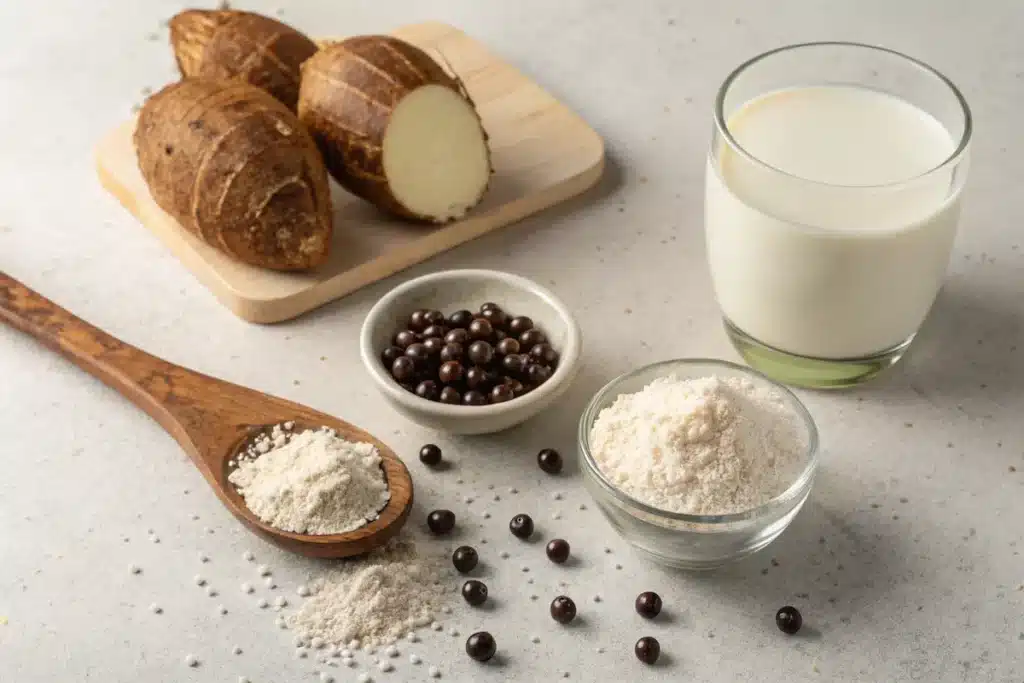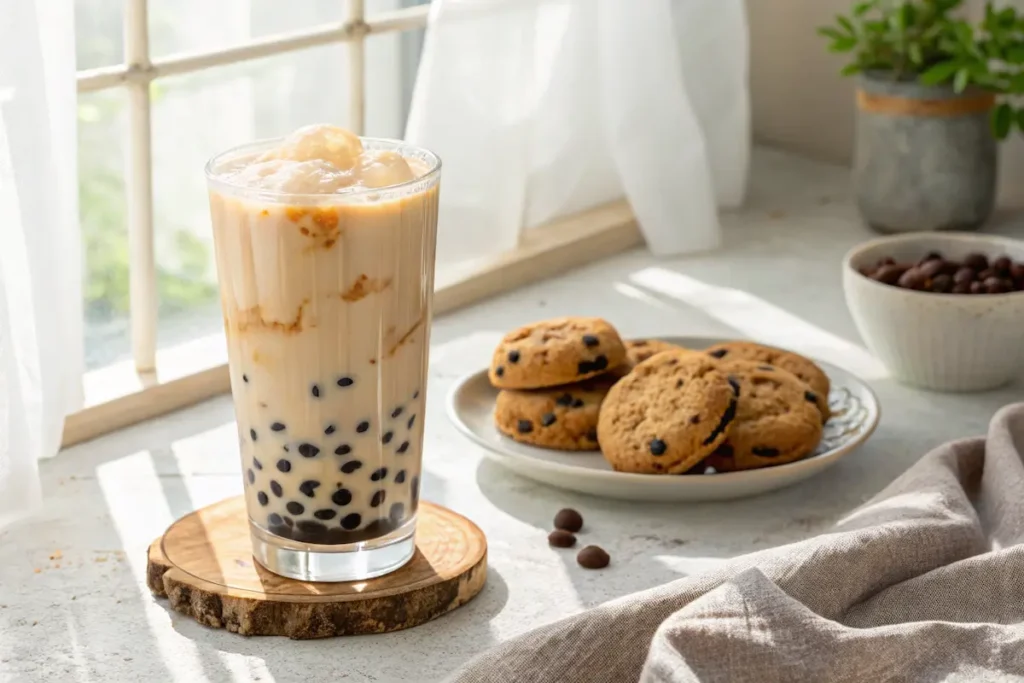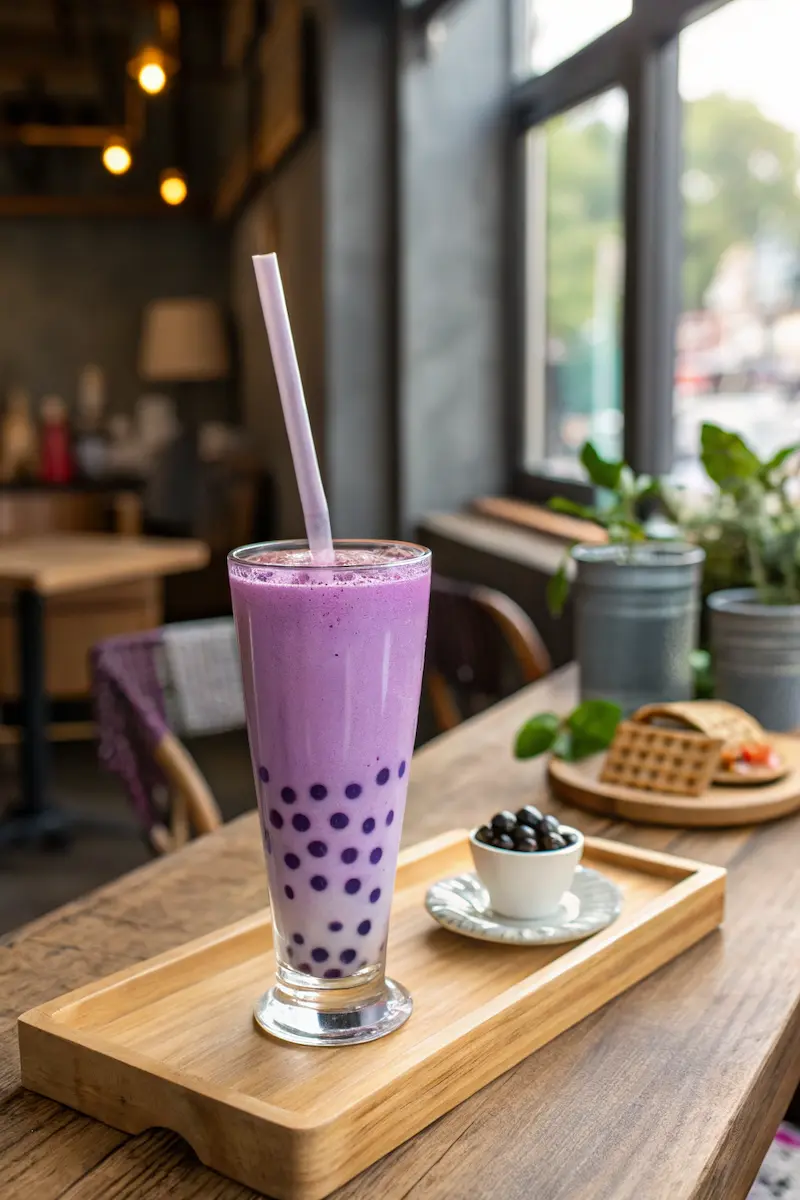Taro milk tea is one of those magical drinks that instantly catch the eye with its vibrant purple hue—but the flavor is where it truly shines. Creamy, nutty, and just a bit sweet, this iconic boba shop staple can be easily recreated at home. Whether you’re drawn to its smooth texture or its naturally comforting notes, taro milk tea is more than a trend—it’s a rich, satisfying drink with cultural depth and plenty of room for customization. In this guide, we’ll show you how to make authentic taro milk tea using real taro, powders, or convenient frozen options.
Table of Contents
Taro Milk Tea – How to Make This Creamy, Colorful Classic at Home
Creamy, nutty, and beautifully purple, taro milk tea is more than a trendy drink—it’s comfort in a cup. Learn how to make it hot or iced with fresh taro, powder, or frozen paste.
- Prep Time: 10 minutes
- Cook Time: 10 minutes
- Total Time: 20 minutes
- Yield: 2 servings 1x
- Category: Drinks
- Method: Boiled or Iced
- Cuisine: Asian-Inspired
Ingredients
- ½ cup cooked taro or 3 tablespoons taro powder
- 1 cup milk of choice (dairy, oat, or coconut)
- 1–2 teaspoons sweetener (honey, sugar, or syrup)
- Optional: ¼ cup brewed black tea
- Optional: Tapioca pearls (cooked)
- Ice cubes (for iced version)
- ½ cup hot water (for iced version)
Instructions
- If using fresh taro, steam until tender, then mash or blend until smooth.
- For hot version: Heat milk gently in a saucepan over medium-low heat (do not boil).
- Stir in taro puree or powder and whisk until smooth and fully dissolved.
- Add sweetener to taste.
- Pour into a mug and optionally add boba pearls. Enjoy warm.
- For iced version: Mix taro powder or mashed taro into hot water until smooth.
- Add sweetener and stir well.
- Fill a tall glass with ice and optional boba.
- Pour in the taro mixture followed by cold milk. Stir or layer as desired.
Notes
Use coconut or oat milk for a dairy-free option. Adjust sweetness and tea strength to your taste. Taro pairs well with jasmine, green tea, or rose blends for added flavor.
Nutrition
- Serving Size: 1 glass
- Calories: 250
- Sugar: 12g
- Sodium: 80mg
- Fat: 7g
- Saturated Fat: 4g
- Unsaturated Fat: 2g
- Trans Fat: 0g
- Carbohydrates: 38g
- Fiber: 1g
- Protein: 3g
- Cholesterol: 10mg
Taro Milk Tea: Creamy, Colorful, and Comforting
The Story & Intro
The first time I tried taro milk tea, I was more curious than convinced. That soft lavender color, the thick texture, the boba pearls—it looked like dessert in a cup. One sip, though, and I was hooked. Smooth, creamy, and surprisingly nutty, taro milk tea felt like a warm hug disguised as a bubble tea. Ever since then, it’s become my go-to whenever I crave something a little different, a little nostalgic, and endlessly comforting.
What is taro milk tea? At its core, it’s a blend of taro root (either in fresh, powdered, or frozen form), milk, and a sweetener—usually sugar or honey. Sometimes served with tapioca pearls, sometimes sipped plain, it’s a drink that wears many hats. It can be a warm, cozy treat or a cool, iced refresher. You’ll find versions across Asia, particularly in Taiwanese bubble tea shops, where it’s a staple flavor.
What makes taro milk tea unique isn’t just its lovely color—it’s the flavor. Taro has a natural nuttiness and creamy starchiness, almost like sweet potato crossed with vanilla. Combined with milk, it turns luxuriously smooth and satisfying, making it a great base for both bold and subtle flavor pairings.
Best of all, it’s highly adaptable. Whether you’re using fresh steamed taro for a natural flavor or taro powder for a quick fix, this drink delivers every time. You can mix in boba, adjust sweetness, or try it with oat milk for a dairy-free twist. Looking to pair it with a snack? It goes beautifully with bite-sized bento cakes or delicate shortbread cookies.
In this guide, we’ll walk you through all the options—fresh or powdered, hot or iced, with or without toppings—so you can create your perfect taro milk tea at home. Whether you’re new to the flavor or already obsessed, you’re in for a treat.
Part 2: Ingredients & Preparation Options
Taro Root or Taro Powder? Understanding Your Base
When making taro milk tea, your base ingredient determines everything from taste to texture. You have three main options: fresh taro root, taro powder, or frozen pre-cooked taro. Each offers a unique experience.
Fresh taro root delivers the most authentic, nutty flavor. It requires peeling, steaming, and blending, but the result is rich and naturally creamy. Fresh taro’s light sweetness and subtle notes of vanilla and nutmeg make it a favorite among purists. If you’re already experimenting with roots like ube, you’ll love this earthy cousin. See how it compares in our ube milk tea guide.
Taro powder, on the other hand, is convenient and beginner-friendly. It’s often pre-sweetened and blended with milk solids or flavorings, producing that iconic lavender hue. Great for quick iced drinks, taro powder mixes well with boba and blends easily with plant-based milks.
Frozen taro blocks or paste offer a middle ground. Often found in Asian supermarkets, they save prep time and retain much of the fresh root’s flavor. Simply thaw, blend, and sweeten to your liking.
Milk Matters: Choosing Your Creamy Companion
Taro milk tea’s creamy finish comes from your choice of milk. Whole milk gives the richest texture and balances taro’s starchiness. For a lighter version, 2% or low-fat milk still offers good body without heaviness.
Going dairy-free? Coconut milk enhances the drink’s tropical feel, while oat milk offers a silky texture that complements the starch of taro. We love pairing it with matcha and coconut milk for a twist.
You can also use evaporated milk for an indulgent feel or almond milk for a mild, nutty finish. The right milk not only blends the drink but enhances its flavor profile.
Sweeteners and Add-ons
Taro is subtly sweet on its own, but most recipes call for a sweetener. Simple syrup, brown sugar syrup, or honey all work well. For a natural touch, try a honey blend like we do in our black tea honey milk.
For toppings, classic boba pearls are a fan favorite. Or opt for grass jelly, pudding, or even cheese foam. Wondering how these additions affect calories? See our full bubble milk tea calories breakdown.
Part 3: How to Make Taro Milk Tea (Hot & Iced)
Hot Taro Milk Tea Recipe
Making hot taro milk tea from scratch is surprisingly simple. You can use fresh taro or powder depending on your time and taste preference.
Ingredients:
- ½ cup cooked taro (or 3 tablespoons taro powder)
- 1 cup milk of choice (dairy, oat, or coconut milk work well)
- 1–2 teaspoons sweetener (honey, sugar, or syrup)
- Optional: ¼ cup brewed black tea for depth
- Optional: Tapioca pearls (cooked)

Steps:
- Prepare Taro: If using fresh taro, steam until tender, then mash or blend until smooth.
- Warm Milk: In a saucepan, heat milk gently over medium-low heat (don’t boil).
- Combine: Stir in taro puree or powder, and whisk until smooth and fully dissolved.
- Sweeten: Add sweetener to taste. You can use honey like in our black tea milk and honey version.
- Serve: Pour into a mug. Add boba pearls if desired. Enjoy warm and creamy.
Pro Tip: Add a splash of black tea (like Assam) for a more complex flavor if you prefer less sweetness.
Iced Taro Milk Tea Recipe
For a chilled version that’s as beautiful as it is refreshing, here’s the quick iced method.
Ingredients:
- 3 tbsp taro powder or ½ cup blended cooked taro
- ½ cup hot water
- ¾ cup milk (cold)
- Ice cubes
- Sweetener to taste
- Optional: Boba pearls
Steps:
- Dissolve: Mix powder or mashed taro into hot water and stir until smooth.
- Sweeten: Add syrup or sugar and mix well.
- Assemble: Fill a tall glass with ice. Add boba if using.
- Pour: Add the taro mixture and follow with cold milk. Stir or layer for visual effect.
Serving Tip: Want to layer your taro and milk like a pro? Pour gently over a spoon or ice cube for a gradient effect. Try this technique with our strawberry milk tea too!
Customization Ideas
- Extra Flavor: Add a splash of vanilla extract, cinnamon, or a pinch of cardamom for warmth.
- Milk Alternatives: Coconut and almond milk pair beautifully with taro’s earthy flavor.
- Toppings: From boba to whipped cream, even purple yam paste—make it your own.
- Tea Blends: Blend taro with jasmine, rose milk tea, or green tea for exciting flavor fusions.
- Sugar-Free Option: Use monk fruit sweetener or stevia if watching sugar intake.

Taro Milk Tea FAQs
What exactly is taro milk tea?
Taro milk tea is a creamy beverage made by blending taro root or taro powder with milk and sweetener. Often served with tapioca pearls as bubble tea, it can be enjoyed hot or iced. Taro adds a nutty, subtly sweet flavor and a signature purple color. You can make it using fresh steamed taro or a quick taro powder mix, similar to how black tea milk and honey can be adjusted to suit your time and taste preferences.
What does taro tea taste like?
Taro has a naturally creamy texture and a flavor that’s often described as a mix of vanilla, sweet potato, and a hint of nuttiness. In taro milk tea, this flavor becomes more mellow and dessert-like when blended with milk and sweetener. It’s unique, cozy, and instantly recognizable. If you enjoy subtle root-based drinks like ube milk tea, you’ll likely love taro as well.
Is taro milk tea healthy?
Taro itself is a fiber-rich root vegetable containing antioxidants, potassium, and vitamins. However, in milk tea form, health depends on your ingredients. Using taro powder with added sugar increases calories, while fresh taro and unsweetened plant-based milk are healthier options. To control calories, reduce sweeteners and avoid heavy toppings. Curious about how it compares? Check out our milk tea calories guide.
Does taro milk tea have caffeine?
On its own, taro has no caffeine, making it a great caffeine-free alternative. However, many shops add black or green tea to deepen the flavor, which introduces caffeine. If you want a caffeine-free version, skip the tea base and stick with just taro and milk—similar to how lavender milk tea can be enjoyed both ways.
Conclusion: A Vibrant Cup of Comfort
Taro milk tea is more than just a pretty drink—it’s a comforting blend of creamy texture, subtle sweetness, and cultural warmth. Whether you’re using fresh taro for its earthy depth or powdered taro for convenience, this beverage is easy to make and endlessly adaptable.
You can enjoy it hot or iced, dairy or dairy-free, with boba or without. It pairs beautifully with light desserts like bento cakes, and its caffeine-free version makes it perfect any time of day. By learning the basics of this flavorful drink, you open the door to a world of delicious variations, from ube to matcha taro fusions.
Now it’s your turn—try it out and make it your own!



1 thought on “Taro Milk Tea – How to Make This Creamy, Colorful Classic at Home”